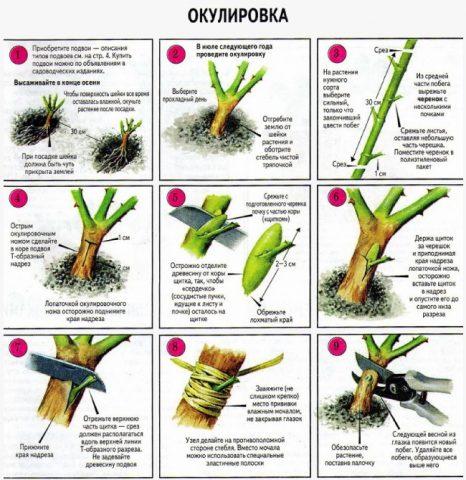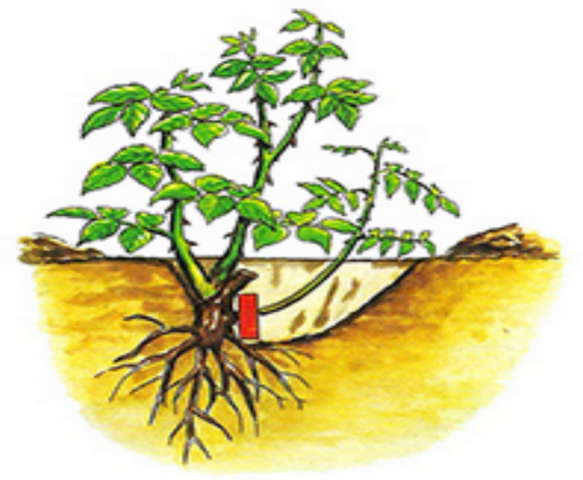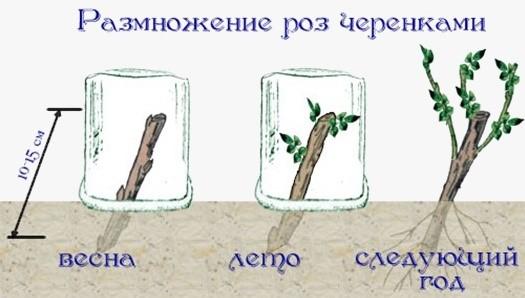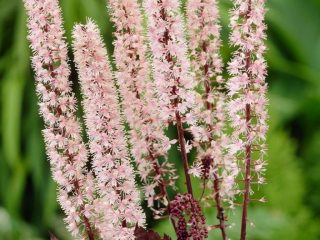Content
Roses pamper gardeners with a variety of species and varieties. The method of growing a seedling affects the characteristics of further care. Therefore, when purchasing, experienced gardeners are interested in whether roses are grafted or rooted.

There are two types of seedlings: rooted from cuttings and grafted onto rosehip rootstock
What does self-rooted roses mean?
Garden nurseries offer a wide selection of planting material. Seedlings grown by rooting cuttings, layering or dividing a bush are self-rooted. Experienced gardeners pay attention to the variety, and not to the method of propagation, because they propagate the plants themselves.
Growing your own roses is not possible in all regions. Most varieties are not frost-resistant, so they are grafted onto a rootstock. The strong roots of rose hips go deep into the ground and feed the young shoots of the bush. In the northern regions, the graft is buried 2-3 cm into the soil, and for the winter it is insulated with humus and spruce branches.

Many gardeners try to get their own roots from cuttings
Roots form after 2-3 months.However, young seedlings still need to be preserved, so a greenhouse is built for them and grown indoors. Young roots may die at temperatures below 0 0C. In the second year, the plant gives strong roots, it is ready to be transplanted into the ground, but for the winter the bush is covered with non-woven fiber. Self-rooted plants are superior to peers grafted onto rosehip rootstock in terms of longevity and luxuriance of flowering.
What are grafted roses
Initially, the plant was brought from warm countries where there are no winters and do not require rest. Therefore, they began to graft roses onto rosehip rootstock in order to strengthen immunity and increase frost resistance.
Many garden nurseries use the budding method, as this significantly speeds up the propagation process. Not every variety produces roots from cuttings, so the grafting method is used.

If the grafting site is buried in the soil, the rose can produce its own roots.
Rosehip is a strong and sometimes aggressive plant, tolerates wintering well, and grows quickly. He transfers all the power to the grafted rose.
If the graft is buried 3 cm into the soil, its own roots may form from the stem. Over time, they will grow, and the plant will receive additional nutrition.
Thus, a grafted rose can become its own root. In autumn, the plant is covered with humus and covered with agrofibre so that the flower survives the winter well. Sometimes the rootstock dries out; in such cases, the rose's own roots will help the rose survive.
Experts advise not to bury floribundas and hybrid tea varieties of roses, as the grafting site rots and the plant dies, leaving the rose hips to grow. Gardeners from the northern regions of the country purchase only grafted plants, because their own rooted flowers cannot withstand harsh winters.
What is the difference between grafted roses and own-rooted ones?
Experienced gardeners do not pay attention to the propagation method, because they know how to grow flowers on their own, they are more interested in the species and variety. The main differences between self-rooted roses and grafted roses are expressed in accelerated development on the rootstock and powerful immunity in radicular roses.
Grafted plants grow in different climatic zones. Self-rooted roses are preferred in the southern regions. Experienced gardeners deepen the grafting site when planting so that the plant grows its roots. This combined method allows you to accelerate the development of the bush and increase immunity.

Park, climbing species and floribundas grow on their own roots and tolerate low temperatures
Pros and cons of own-rooted roses
Any plant has a number of advantages and disadvantages. Positive characteristics include the following:
- resistance to viral diseases;
- winter-hardy qualities increase;
- the bush lives for more than ten years;
- abundant flowering;
- lack of growth;
- when the branches freeze, the root collar remains alive, and new shoots grow from dormant buds.
In addition to their advantages, self-rooted roses have a number of disadvantages. Negative qualities include:
- young seedlings slowly increase their mass, so the plant is vulnerable;
- long process of reproduction;
- high demands on soil composition.
Pros and cons of grafted roses
Bubbled plants are more vulnerable. Severe frosts can damage the above-ground part, but since they have rosehip roots, the rose will not resume its growth. In addition, the grafting site may rot or rot.
The lifespan of a grafted rose is up to five years. Over time, the root collar is suppressed by wild rose hips, and the bush outgrows. In addition to the disadvantages, the budded plant has the following advantages:
- multiply quickly;
- good survival rate of even weak cuttings;
- all types and varieties take root;
- the plant quickly gains mass.

Grafts with weak eyes may suffer during wintering and spring floods
How to plant your own root roses
Before planting the cuttings, prepare the soil. Light, well-drained soils rich in humus are suitable for self-rooted roses. Moisture is retained in the clay substrate, as a result the graft or root collar rots.
The shrub loves warm regions, so choose a place in a sunny area or in partial shade. Clay is not thermally conductive; therefore, sand and humus are added to loamy soils. In hilly areas, south-western slopes are chosen.

Cuttings are harvested in summer, spring and autumn, 10-15 cm long
Faded young shoots are selected for seedlings. Roses are propagated and planted according to the following step-by-step instructions:
- On cuttings 10-15 cm long, three internodes are left.
- The bottom of the cutting is cut at an angle of 450, at the same time 5 cm are retreated from the kidney, 1 cm is left on top.
- The lower leaves are removed and the upper ones are cut in half.
- Prepare a substrate from sand, humus and peat in a 1:1:1 ratio. They fall asleep in the greenhouse. Lightly moisten the soil.
- The cuttings are buried 2 cm, leaving a distance between seedlings of 5 cm.
- Cover with a lid and place in a warm shaded place with a temperature of 23-25 0C. Periodically ventilate and moisten the soil with a spray bottle.
- After three weeks, open the lid. The seedlings are transplanted into separate pots.
- Next year in the spring, planting holes 10-20 cm deep are prepared. Humus, peat and sand are added to the bottom. Mix the soil.
- The seedlings are removed from the pots along with a lump of earth. Place so that the root collar is 3-4 cm below the surface.
- The seedling is buried, thoroughly watered and mulched with humus.
Caring for your own root rose
Young seedlings are fertilized once every two weeks in the summer. Roses love humus, so experienced gardeners infuse manure or droppings in water 1:1 for 10-15 days. Mineral fertilizers are also added. Rose responds well to boron, potassium and phosphorus. Fertilizers should be applied according to the manufacturer's instructions. Excessive feeding can lead to the opposite effect, and the plant will dry out.
In autumn, faded vines are cut off. Green twigs are also removed; they have not yet become woody and will not withstand frost. In September-November, roses are covered with humus. Young bushes are hilled to a height of 15 cm. In the northern regions, the above-ground part is pressed to the ground and covered with spunbond, leaving an air space. Some build wooden boxes. During wintering, potassium-phosphorus fertilizers are applied at the root.
In spring, the shelter is removed gradually, when night frosts stop and a constant night temperature of +5-10 is established. 0C. A complex of mineral fertilizers containing a higher nitrogen content is applied.
Conclusion
Grafted or self-rooted roses have a number of pros and cons. Knowing the type of propagation, it is easier for the gardener to care for the plant. Nurseries offer customers grafted seedlings that quickly grow.








